PCB Types
There are several different types of circuit boards, each with its own particular manufacturing specifications, material types, and usages:
Single-layer PCB
A single-layer or single-sided PCB is one that is made out of a single layer of base material or substrate. One side of the base material is coated with a thin layer of metal. Copper is the most common coating due to how well it functions as an electrical conductor. Once the copper base plating is applied, a protective solder mask is usually applied, followed by the last silk-screen to mark out all of the elements on the board.

Since single-layer/single-sided PCBs only have their various circuits and components soldered onto one side, they are easy to design and manufacture. This popularity means that they can be purchased at a low-cost, especially for high-volume orders. The low-cost, high volume model means they are commonly used for a variety of applications, including calculators, cameras, radio, stereo equipment, solid state drives, printers and power supplies.
Double-layer PCB
Double-layer or double-sided PCBs have a base material with a thin layer of conductive metal, like copper, applied to both sides of the board. Holes drilled through the board allow circuits on one side of the board to connect to circuits on the other.

The circuits and components of a double-layer PCB board are usually connected in one of two ways: either utilizing a through-hole or with the use of a surface-mount. A through-hole connection means that small wires, known as leads, are fed through the holes, with each end of the leads then soldered to the right component.
Surface mount PCBs don't utilize wires as connectors. Instead, many small leads are soldered directly to the board, meaning that the board itself is used as a wiring surface for the different components. This allows circuits to be completed using less space, freeing up space to allow the board to complete more functions, usually at higher speeds and a lighter weight than a through-hole board would allow.
Double-sided PCBs are typically used in applications which require an intermediate level of circuit complexity, such as industrial controls, power supplies, instrumentation, HVAC systems, LED lighting, automotive dashboards, amplifiers and vending machines.
Multi-layer PCB
Multi-layer PCBs consist of a series of three or more double-layered PCBs. These boards are then secured together with a specialized glue and sandwiched between pieces of insulation to ensure that excess heat doesn't melt any of the components. Multi-layer PCBs come in a variety of sizes, going as small as four layers or as large as ten or twelve. The largest multi-layer PCB ever built was 50 layers thick.
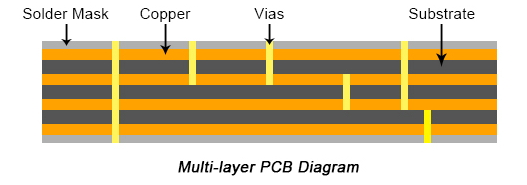
With many layers of printed circuit boards, designers can make very thick, complex designs which are suitable for a broad range of complicated electrical tasks. Applications WHERE multi-layer PCBs would be beneficial include File servers, Data storage, GPS technology, Satellite systems, Weather analysis and Medical equipment.
Rigid PCB
Rigid PCBs are made out of a solid substrate material that prevents the board from twisting. Possibly the most common example of a rigid PCB is a computer motherboard. The motherboard is a multilayer PCB designed to allocate electricity from the power supply while simultaneously allowing communication between all of the many parts of the computer, such as CPU, GPU and RAM.
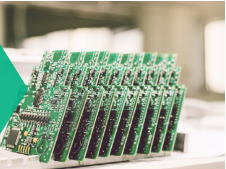
Rigid PCBs make up perhaps the largest number of PCBs manufactured. These PCBs are used anywhere that there is a need for the PCB itself to be set up in one shape and remain that way for the remainder of the device's lifespan. Rigid PCBs can be anything from a simple single-layer PCB all the way up to an eight or ten-layer multi-layer PCB.
All Rigid PCBs have single-layer, double-layer or multilayer constructions, so they all share the same applications.
Flexible PCB
Unlike rigid PCBs, which use unmoving materials such as fiberglass, flexible printed circuit boards is made of materials that can flex and move, such as plastic. Like rigid PCBs, flexible PCBs come in single, double or multilayer formats. As they need to be printed on a flexible material, flexible pcb cost more for fabrication.
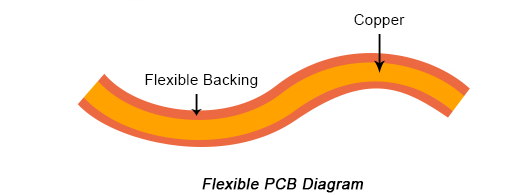
Still, flexible PCBs offer many advantages over rigid PCBs. The most prominent of these advantages is the fact that they are flexible. This means they can be folded over edges and wrapped around corners. Their flexibility can lead to cost and weight savings since a single flexible PCB can be used to cover areas that might take multiple rigid PCBs.
Flexible PCBs can also be used in areas that might be subject to environmental hazards. To do so, they are simply built using materials that might be waterproof, shockproof, corrosion-resistant or resistant to high-temperature oils - an option that traditional rigid PCBs may not have.
Rigid Flex PCB
Rigid flex circuits combine the best of both worlds when it comes to the two most important overarching types of PCB boards. Flex-rigid boards consist of multiple layers of flexible PCBs attached to a number of rigid PCB layers.
Flex-rigid PCBs have many advantages over just using rigid or flexible PCBs for certain applications. For one, rigid-flex boards have a lower parts count than traditional rigid or flexible boards because the wiring options for both can be combined into a single board. The combination of rigid and flexible boards into a single rigid-flex board also allows for a more streamlined design, reducing the overall board size and package weight.
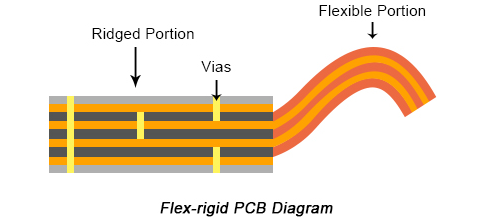
Flex-rigid PCBs are most often found in applications where space or weight are prime concerns, including Cell phones, Digital cameras, Pacemakers and Automobiles.
Aluminum-Backed PCB
Aluminum-backed PCBs are designed in much the same way as their copper-backed counterparts. However, instead of the usual fiberglass used in most PCB board types, aluminum circuit board make use of aluminum or copper substrate board.
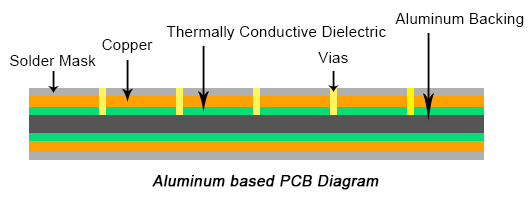
The aluminum backing is lined with thermally insulating material that is designed to have a low thermal resistance, meaning less heat is transferred from the insulating material to the backing. Once the insulation is applied, a circuit layer of copper, ranging in thickness from one ounce to ten, is applied.
Aluminum-backed PCBs have many advantages over PCBs with a fiberglass backing, including:
· Low cost. Aluminum is one of the most abundant metals on Earth, making up 8.23% of the planet's weight. Aluminum is easy and inexpensive to mine, which helps to cut expenses in manufacturing process. Thus, building products with aluminum is less expensive.
· Environmentally friendly. Aluminum is non-toxic and easily recyclable. Due to its ease of assembly, manufacturing printed circuit boards out of aluminum is also a good way to conserve energy.
· Heat dissipation. Aluminum is one of the best materials available for dissipating heat away from crucial components of circuit boards. Instead of dispersing the heat out into the rest of the board, it transfers heat out into the open air. Aluminum PCB cools faster than an equivalent-sized copper PCB.
· Material durability. Aluminum is far more durable than materials like fiberglass or ceramic, especially for drop tests. The use of sturdier base materials helps reduce damage during manufacture, shipping and installation.
All of these advantages make Aluminum PCB an excellent choice for applications require high outputs of power within very tight tolerances, including traffic lights, automotive lighting, power supplies, motor controllers and high-current circuitry.
In addition to those major areas of use, aluminum-backed PCBs can also be used in applications that require a high degree of mechanical stability or where the PCB might be subject to high levels of mechanical stress. They are less subject to thermal expansion than a fiberglass-based board, meaning that the other materials on the board, such as the copper foil and insulation, will be less likely to peel away, further lengthening the lifetime of the product.
Throughout the years, PCBs have evolved from the simple single-layer PCBs used in electronics such as calculators to more complex systems, such as a high-frequency Teflon design. PCBs have found their way into almost every industry on the planet, from simple electronics like lighting solutions all the way up to more complex industries like medical or aerospace technology.
The evolution of PCBs has also pushed a development in PCB building materials: no longer are PCBs built solely out of fiberglass-backed copper foil. New construction materials include aluminum, Teflon and even bendable plastics. Bendable plastics and aluminum, in particular, have spurred the creation of products like rigid-flex and aluminum-backed PCBs to address the common problems associated with many industries.
Capacités
Capacité PCB rigide
Capacité PCB flexible
Capacité d'assemblage PCB
Équipement PCB
Équipement d'assemblage PCB
Méthodes de paiement
Prix spéciaux
Transporteurs
Support pour amateurs
Certificat
Assistance clientèle
Suivez-nous
Tel: 1-905-339-2881
Email: sales@goldphoenixpcb.com , tech@goldphoenixpcb.com
Copyright Gold Phoenix PCB Co., Ltd. 2011 - 2025
Tel: 1-905-339-2881 Email: sales@goldphoenixpcb.com , tech@goldphoenixpcb.com
Système de contrôle qualité | Service produit
| Liens
Copyright Gold Phoenix PCB Co., Ltd. 2011 - 2025


